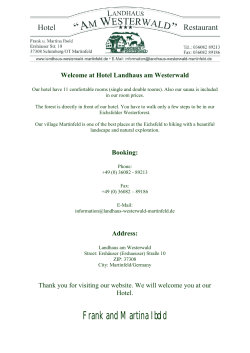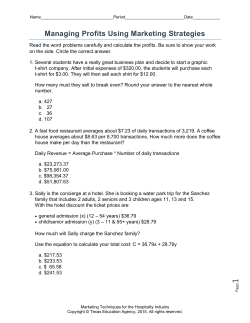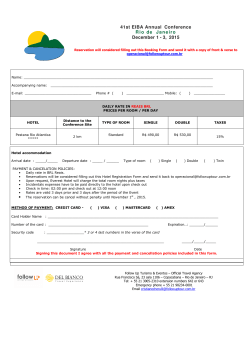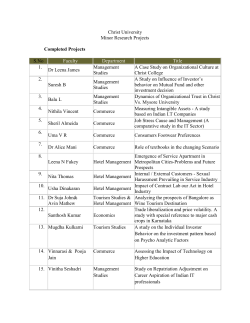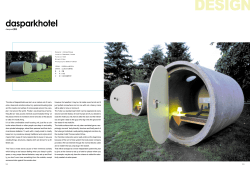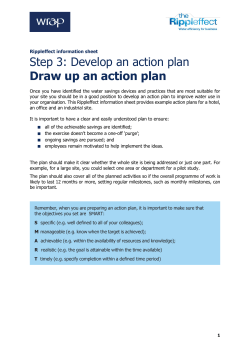
Bueno, DC International Conference on ASSHIS-17 Dec 17-18 2017
10th MANILA International Conference on Arts, Social Sciences, Humanities and Interdisciplinary Studies (ASSHIS-17) Dec. 17-18, 2017 Manila (Philippines) Green Practices as Corporate Social Responsibility towards BUENO Framework for Hotel Industry in Subic Bay Freeport Zone Prof. Dr. David Cababaro Bueno Columban College, Inc. –Olongapo City Abstract—The study focuses on the analysis of green practices of selected hotels in Olongapo City as element of Corporate Social Responsibility (CSR) towards a Best Unified Environmental and Natural Opportunities (BEUNO) framework for the hotel industry. The researcher used the descriptive cross-sectional design by employing a selfadministrated and closed-ended questionnaire to survey the participants within a specified time frame of the study. The ten conveniently selected hotels in the Subic Bay Freeport Zone (SBFZ) were taken from the directories of the Department of Tourism (DOT) in the City. Thus, there were 10 hotel employees and 10 guests (consumers) from each hotel, who served as participants during the conduct of the study. The adopted checklist was subjected expert validity and reliability test. Data were analyzed using the Statistical Package for Social Sciences 2.0 (SPSS 20.0). Turning off lights and appliances in unoccupied rooms, taking advantage of the natural lights, and replacing damaged doors/ windows are the observable green practices. Encouraging guests to report water leaks is at all times observed, while collecting rainwater for irrigating or other non-potable use, and presoaking utensils and dishes in ponded water instead of using a running water rinse are frequently done. Solid waste and pest management practices are also done. Eliminating bird nests; making the rooms free from trash and checking for cooking odors, ensuring the ventilation system, and cleaning spills promptly are constantly observed among hotels. Preserving existing vegetative cover, pest management, grounds keeping and green food service management are regularly practices. There is no significant difference in the assessment of the participants on energy and water conservation, solid waste and pest management, indoor air quality maintenance, and grounds keeping. However, there is significant difference on building renovation and mold growth prevention practices. The BUENO framework should be adopted for sustainable social responsibility of green hotels Keywords –Corporate social responsibility, green practices, BUENO framework, hotel industry, SBFZ, Olongapo City, Philippines Manuscript submitted on September 2, 2017 for review. This work was funded by the Research and Publications Office of Columban College, Inc., - Olongapo City, Philippines. Dr. David Cababaro Bueno, author, is the Dean of the Graduate School, and concurrent Director of Research and Publications Office of Columban College, Inc. I. INTRODUCTION Tourism is part of the fastest growing industries in the world, making it an important contributor to the world economy. On a global basis, tourism currently generates approximately 9% of the gross domestic product (GDP) (World Travel & Tourism Council, 2013). Additionally to economic success, however, companies are increasingly taking their social and environmental impacts into consideration and create business strategies that reflect these. Within the tourism industry, this subject seems to be of particular importance as continuous tourism development results in numerous negative impacts on destinations, including energy and water consumption, loss of biodiversity, increased pollution, and waste management problems to only name a few (Lund-Durlacher,2013). These problems induce tourism businesses to operate in a way that mitigates these effects and indicate that there are numerous opportunities for doing so. Including Corporate Social Responsibility (CSR) in daily operations and company philosophy has therefore become a key part of conducting business in the industry. Sustainability and environmental management have become one of the most critical management issues facing companies in a wide range of industries as well as hospitality firms as a result of growing environmental awareness among consumers, governments and social groups and employees. Reflecting this large scale trend, a number of research initiatives have been undertaken to address these emerging issues in the hospitality industry context. The focus has been on identifying environmental management initiatives some green hotels have been making (Mensah, 2010). Growing consumer awareness and attitudes toward environmental issues and green products and services has been explored by some researchers (Manaktola & Jauhari, 2011). Identification of motivations for going green has also been the focus of a host of studies (Tzschentke, Kirk, & Lynch, 2008). The World Commission on Environment and Development (1987) and International Hotels Environmental Initiative (1992), started acting as a catalyst for greening hospitality practices (Tzschentke et al., 2008). Since then, many hotel companies have participated in the green initiatives and adopted a proenvironmental policy. It has been reported that many hotels have taken advantage of their environmental initiatives through responding to customers’ increasing environmental concerns (Manaktola & Jauhari, 2011), thereby enhancing corporate image, and achieving a high level of energy and resource efficiency. Much previous research across a range of disciplines has attempted to identify forces that motivate and encourage firms to react to environmental issues. Stakeholders such as customers, local communities, government agencies, and public interest groups are considered relevant parties that affect environmental decision-making and actions, which in turn, have an impact on the stakeholders (Banerjee, 2012). Organizational capabilities and the availability of resources to implement a proactive environmental management strategy also largely influence managerial decision-making. Some research has pointed out that managerial perceptions of various environmental issues such threats and opportunities associated with environmental issues have influences on corporate environmental responses (Lee & Rhee, 2008). Other research efforts have been undertaken to identify management’s perceived motivations to go green in the hospitality context. They include financial benefits, improved stakeholder relationships and ethical concerns (Tzschentke et al., 2008). These motivations to go green are inevitably determined by the way top managers see the environmental issues as well as various internal and external factors that are relevant to their organizations as “managers’ personal values can be a motivating factor” for corporate social responsibility (Heminway & Maclagan, 2014). In addition, given that “corporate environmentalism is the recognition of the importance of environmental issues facing the firm” (Banerjee, Lyer, & Kashyap, 2012), firms within a common industry context tend to implement similar environmental management strategies since they have similar situational contexts such as relationships with stakeholders and government regulations. However, some studies have also argued that corporate environmental management strategy can be different among companies operating within the same industry, which has similar social, regulatory, and public policy contexts (Sharma & Vredenburg, 2008). Furthermore, it is found that green practices among small lodging operations are mainly driven by ownermanagers’ principled concerns about the natural environment. This implies that top managers’ attitudes toward environmental issues might be directly linked to and affects hotels’ response to those issues. Plentiful empirical evidence has suggested that psychological factors such as individual values and environmental attitudes underlie environmentally conscious behaviors. The concept of Corporate Social Responsibility (CSR) has been considered as open and transparent business practices, which is based on ethical values and respect for the community, employees, the environment, shareholders and other stakeholders (Matten and Moon, 2015). The foundation for the adoption of CSR is the acknowledgement that businesses have responsibilities to society that goes beyond shareholder wealth maximization. Some authors have suggested a more focused approach which just looks at the extent and nature of interaction between business activities and the natural environment. Sheldon and Park (2011) also suggested that for most travel related companies the ecological aspects of CSR are easier to apply. The term Corporate Environmentalism (CE) has therefore been adopted in this way (Banerjee, Iyer et al. 2012). Bannerjee proposed that Corporate Environmentalism includes two dimensions: environmental orientation and environmental strategy (Banerjee, Iyer et al. 2012). Thus, we can define Corporate Environmentalism as recognition of the importance of environmental issues facing the firm and the integration of those issues into the firm strategic plans. Furthermore, Stakeholder Theory (ST) exposed that hotel companies are being prompted by rising energy costs, government pressure, consumer expectations and the competitive landscape to increasingly make sustainability a top priority, and it may be impacted by a company's performance (Banerjee 2012; Banerjee, Iyer et al. 2012). The manner in which a firm response to the stakeholders depends on its environmental orientation, so public concern is an important antecedent to corporate environmentalism. In the political/economic framework, a company's choice of strategies in complex social environments is driven by consideration of political and economic forces within and external to the firm. A clear political external force is that of regulations which increasingly govern and affect environmental strategy is a public concern (Adlwarth 2010; Conrady and Buck 2010). There is increasing pressure for corporations to disclose the sustainable management practices. Accordingly, Hanniffa and Cook (2015) reported that an environmental credentials are one way to legitimize the actions of the corporation to reduce legitimacy gaps between organizations and society. One way of lessening this gap is by reporting activities to stakeholders and through additional disclosure, and this reporting is becoming the norm in international hotel companies with prominent links displayed on their websites. The shared concern for the environment is another concept considered. It can be a possibility that public concern will be positively related to environmental orientation. As such, they have realized that it is possible that their purchasing decisions may directly impact the environment (Jin-Soo, Li-Tzang et al. 2010). Increasing public concern is stimulating the implementation of environmentally responsible management in the hotel industry (Wolfe and Shanklin 2011). Moreover, regulatory forces were recently introduced in various countries to include taxes on energy, waste and carbon emissions. These have led many companies to adopt more rigorous environmental strategies to ensure the conformity. Thus, organizations of all kinds have grown much more aggressive and effective in bringing public pressure to bear on companies (Porter, 2006). Many hotel companies operate in fragile and delicate natural environments and so are not only at the mercy of environmental activism within the countries in which they operate but also from the clients themselves who want to continue to see and interact with these environments. This tension between the interaction and the customer’s desire for a fully serviced hotel/tourism environment is a fundamental problem within the industry in deciding carrying capacity. In spite of a wide range of literature on environmental issues in the hospitality industry context, little research has been conducted to explore on green initiatives hotel industry in SBFZ. Thus, this study examines the green practices towards a Best Unified Environmental and Natural Opportunities (BUENO) framework for hotel industry. II. OBJECTIVE OF THE STUDY The study focuses on the analysis of green practices as corporate social responsibility among hotels in SBFZ towards a BUENO framework for the hotel industry. It specifically aims to: (1) determine the green practices of selected hotels; (2) analyze the significant variations on the assessment of the green initiatives when grouped according to respondents; (3) propose the BUENO framework. III. METHODOLOGY The researcher used the descriptive cross-sectional design using a validated and reliable closed-ended questionnaire. It is one of the common study designs to describe the participants’ perceptions on green practices during the specified period of study. The cross-sectional design is an observational study using a validated instrument. This means that researcher recorded information about the participants without manipulating the study environment. In short, the researcher tried not to interfere while the participants were surveyed using a well-defined instrument and compared the different perceptions and various variables within the specified time frame (Bueno, 2017). The ten conveniently selected hotels in the Subic Bay Freeport Zone (SBFZ) were taken from the directories of the Department of Tourism (DOT) in the City. Thus, there were 10 hotel employees and 10 guests (consumers) from each hotel, who served as participants during the conduct of the study. Bueno (2015) described convenience sampling as a sampling technique used to obtain units or respondents who are most conveniently available. The adopted checklist was subjected expert validity and reliability test. The adopted survey-checklist was tried-out to hotel industry practitioners, researchers, Science professors, selected students and parents for face and construct validity only. The instrument was subjected to a reliability test. Alpha coefficients were energy conservation (.81); water conservation (.79); solid waste management (.91); indoor air quality maintenance (.87); building renovation (.76); pest management (.84); grounds keeping maintenance (.81); food service management (.90); and mold growth prevention (.89). An alpha coefficient of 0.70 or higher indicates acceptable levels of internal reliability, which means that all the items in the same category measure the same attribute. Thus, the instrument validity and reliability were established. The survey-questionnaire used a 5-point Likert scale (5; 4; 3; 2; 1) items based on a scale from “5 = strongly agree” to “1= strongly disagree”. Data were gathered between April and June in 2017. Initially, a survey packet, a brief explanation as to the nature of the research, an informed consent form, and survey-questionnaire was sent to the hotel managers through the guest relations officers. The hotels were first contacted based on convenience of location. After obtaining permission from the hotels, the researchers visited the hotels to hand out the survey-questionnaires to the workers. The researcher visited each department at the hotels and explain the nature of the study of the head of the department. The survey collection boxes were set up in a designated area, the employees’ and guests’ entrance or cafeteria for a week, so employees and guests could drop of the survey as they came in and out. The location of those boxes was given to the head of each department. Follow-up visitations were made to the guest relations officers, seven days after the initial visitation. Data were analyzed using the Statistical Package for Social Sciences 2.0 (SPSS 20.0). IV. RESULTS AND DISCUSSION Green Practices. Energy conservation practices include turning off the lights when not in unoccupied rooms, taking advantage of the natural lights, and turning off appliances during non-use hours are the observable green practices among the hotels. Participants also observed the practices such as replacing damaged doors or windows to reduce the need for cooling in the building, and sometimes observed cleaning lights and fixtures regularly to keep the light output high. The overall computed means are 4.31 (always) and 3.98 (oftentimes), for the employees and hotel guests, respectively. Moreover, water conservation practices of hotels are encouraging guests to report water leaks to the hotel staff is always observed. Fixing leaks in faucets, toilets, and pipes right away are sometimes observed. Other practices such as collecting rainwater for irrigating or other non-potable use, and presoaking utensils and dishes in ponded water instead of using a running water rinse are oftentimes observed by all the participants. The overall computed means are 4.00 (oftentimes) and 3.89 (oftentimes), for the hotel staff, and guests, respectively. Some green practices of hotels in terms of solid waste management are encouraging guests to reduce waste, recycling items such as papers, aluminum cans and plastic bottles, and segregating dry solid wastes to wet solid waste. Sharing of periodicals with associates, instead of receiving multiple copies is oftentimes observed by all participants; and saving of used papers, envelopes, and folders for in-house reuse is always observed by them. The overall computed means are 4.22 and 3.99, for the hotel staff and guests, respectively. In addition, the practices in terms of indoor air quality maintenance, eliminating bird nests or droppings near outdoor air intakes; ensuring that rooms are free from trash and chemical substances, and checking for cooking odors or smoke in areas adjacent to cooking preparation and eating areas, ensuring that ventilation system allows adequate amount of outdoor air to enter the room, and cleaning spills promptly are always observed. The overall computed means are 4.30 (Always), and 3.80 (Oftentimes), for the staff, and hotel guests, respectively. The green practices in terms of building renovation such as preserving existing vegetative cover and trees; ensuring that walls, floors, roofs and windows are as energy efficient as possible; maximizing the use of natural daylight in building interiors as a source of ambient light; and considering the on-site materials such as gravel and sand for construction is always observed. Orienting the building to catch the breezes, minimize heat gain and make use of natural shading and light is oftentimes observed by all the participants. Computed means are 4.27 (Always) and 3.82 (Oftentimes), for the hotel employees, and guests, respectively. While, pest management as an integral dimension of the green practices among hotels is practiced by spraying pesticides when children are out of reach; keeping lockers and the building clean and dry; and storing pesticides in leak-proof containers in a secure place. Moreover, practicing good sanitation and proper maintenance of structures and grounds is always observed, but fixing plumbing leaks and other moisture problems are sometimes observed. Thus, these ecofriendly practices are oftentimes observed by the respondents as evidenced by the computed means of 4.00 and 3.87, respectively. Cutting of grass on a regular basis; practicing spot application of fertilizer where a problem exists instead of the entire area; and using a minimal amount of fertilizers on grounds is oftentimes observed by the participants. Preserving local vegetation in place, especially mature trees; and keeping the grounds free from unwanted materials that can cause an accident is always observed. The overall computed means are 4.58 (Always) and 3.97 (Oftentimes), for the staff, and guests, respectively. The food service aspect of the green practices among hotels are using of washable wiping cloths instead of disposables; keeping records for the demand for particular foods and use them in menu planning; printing of daily specials on a chalkboard rather printing daily specials on new sheets of paper; and using of refillable condiment bottles instead of single use packaging are oftentimes observed by all the respondents. Reusing of large containers for storage is always observed by the participants. The computed means are 3.99 and 3.96, for the hotel staff, and guests, respectively. Lastly, mold growth prevention practices among hotels are keeping building materials like wood, paper and fabric dry; fixing the source of the water problem or leak to prevent mold growth; avoiding standing water in ventilation systems, air conditioning units or refrigerator drip pans; and preventing rainwater from entering air intakes are always observed by the participants. Inspecting comfort rooms for signs of standing water, water stains or molds is oftentimes observed. The computed means for these observations are 4.65 and 3.98, for the hotel staff, and guests, respectively. Difference in the Assessments of the Green Practices. The null hypothesis is accepted for the variables such as energy conservation, water conservation, solid waste management, indoor air quality maintenance, pest management, and grounds keeping. Thus, there is no significant difference in the assessment of green practices along these variables when grouped according to the participants. However, the null hypothesis is rejected in relation to building renovation and mold growth prevention practices. Thus, there is a significant difference in the assessment of eco-friendly practices along these variables when grouped according to the participants. The BUENO Framework for Hotel Industry. The growing concern with environmental issues and their impact on general awareness is part of the most noticeable phenomena of the last two decades. Increase in economic activities in developing states results in more energy and consumption demand, which generally leads to environmental degradation. There is a conventional belief that such environmental degradation would resolve as soon as these countries grow economically, since that would give them the opportunity to afford environmental friendly technology as well as eco-friendly strategies, regulations and policies. However, several studies indicated that many developing countries already equipped with environmental policies, legal frameworks and economic instruments, which are considered highly sophisticated by international standards and yet face the worsening of environmental conditions. Major difficulties these countries confront are not only the lack of a legal and economic framework for environmental protection, but also lack of participation among the general public in pro-environmental behaviors. Some of the environmental problems which are critical in the present are fairly widely known because of the growing awareness of all levels of society, including governments, the general public and the scientific community. However, the present study is just trying to discuss the green practices in the hotel industry towards framing a Best Unified Environmental and Natural Opportunities (BUENO) for the hotel industry. In the end of the 20th century, the environmental concerns grew much greater, not only among the developed countries, but also in some developing and underdeveloped nations. The common reason was that the consequences of environmental damages to some vital resources became so apparent and horrifying that governments became worried and mass media found of great value for their headlines; this is due to the public concern (Karimi, 2003). Clear‐cutting of forests for agriculture and other forms of development, depletion of the ozone layer, degradation of fish stocks, erosion of the top soil, pollution of water resources, accelerated rate of extinction of species, destruction of varieties of ecosystems and global warming are few examples of environmental issues as a result of the Industrial Revolution followed by exponential development of science and technology which are considered as the main causes for ever‐growing environmental degradation. Major consequences of industrial revolution included development of powerful tools and technologies for overcoming the negative characteristics and limiting forces of nature, and changes in lifestyles that result in increased demand for resources, and utilization of natural resources (Karimi, 2003). Beside of destructive trend on environment during and after the industrial revolution, sluggish grew on the environmental awareness and initiatives revealed bitter consequences of the environment. The most helpful initiative, activities and movements resulted in international, regional and local agreements addressing specific issues are the increase of environmental awareness. International Environmental Events and Multilateral Environmental Agreements are few of the many improvements that emphasize the importance of the role of environmental education in safeguarding different components of the environment. Also there is different ways such as environmental education and introducing environmental issues to public for protection of the environment Khorshid Dost, (2003). Most of the Multilateral Environmental Agreements (MEAs) recognize absence of environmental awareness and proper environmental education as the main cause of major environmental problems and issues. This emphasizes provision of Public Environmental Awareness and Environmental Education for all age levels of human communities/societies. Facilitation of public participation in decision making, planning, implementation and monitoring environmental plans and projects are also strongly recommended by most of these agreements. Education for environment might do well if it purposely directed towards school students. Understanding related to education started on (1986) which emphasized that “there is a paramount need to create a consciousness of the environment. It must permit all ages of sections of the society, beginning with child (Chethana, 2003). Environmental education has developed as reasonable way to answer the problems and concerns of environment. The concept of environmental education is still developing and waiting to find a right place in the educational systems. Thus, effective strategies for improving overall hotel environment, health and safety are the conduct thirdparty, multimedia compliance audits to identify areas of vulnerability, establishment of programs to improve environmental-management programs; and creation of a framework for an environmental management system that can sustain and improve environmental compliance. Third-party audits could be a useful tool to prepare for an inspection. They identify compliance issues and areas of vulnerability. In fact, these audits can serve as simulated inspections that help educate and create campus wide awareness of compliance using the BUENO framework. V. CONCLUSIONS AND RECOMMENDATIONS Thus, there is no significant difference in the green practices among hotels along with energy conservation, water conservation, solid waste management, indoor air quality maintenance, pest management, and grounds keeping based on the assessment of the participants. However, significant difference in the assessment relative to building renovation and mold growth prevention practices was found. The hotel industry should always observe energy and water conservation. They should always maintain the quality of indoor air, proper laboratory waste disposal, ground keeping, building renovation, pest and mold prevention; maintain proper food management services; regularly conduct orientation activities on proper laboratory waste disposal, mold growth prevention, and benefits of proper building renovations; regularly observe the best practices on energy and water conservation, solid waste and pest management, maintenance of indoor air quality and grounds keeping. The BUENO framework for hotel industry should be used as stepping strategy to actively and functionally implement the pro-environment practices and natural remedies as part to their corporate social responsibility. ACKNOWLEDGMENT The author acknowledges the assistance of the research staff and the MBA students in monitoring the gathering of data, and Columban College, Inc. for funding the study. REFERENCES Adlwarth, W. (2010). Corporate social responsibility: customer expectations and behavior in the tourism sector. Trends and Issues in Global Tourism 2010. Heidelberg, Berlin: Springer Verlag. Banerjee, S.B. (2012). Corporate environmentalism: perspectives from organizational learning. Management Learning. Banerjee, S.B., Lyer, E.S., & Kashyap, R.K. (2012). Corporate environmentalism: antecedents and influence of industry type. Journal of Marketing. Bueno, D.C. (2016). Research Wiring Made Easy. Great Books Publishing. Quezon City, Philippines. Bueno, D. C. (2016). Fundamentals of Statistics. Great Books Publishing. Quezon City, Philippines. Bueno, D. (2017). Research Skills of the Professorial Lecturers: Input to Capability Building. JPAIR Institutional Research, 9(9), 1-17. doi:10.7719/irj.v9i9.489 Bueno, D. (2017). Ascertaining the Curriculum Relevance of the Graduate School through Tracer Study in a Philippine Private Higher Education Institution. JPAIR Multidisciplinary Research, 28(1). doi:10.7719/jpair.v28i1.502 Chethana, S., (2003). Effect of background variables on the environmental attitude of 9th. Department of Studies and Research Education, Karnataka State Open University, Mysore. 131-153. Conrady, R. & Buck M. (2010). Trends and Issues in Global Tourism 2010. Heidelberg, Berlin: Springer Verlag. Hanniffa and Cook. (2015). An Investigation of Green Hotel Customers’ Decision Formation: Developing an Extended Model of the Theory of Planned Behavior. Int. J. Hosp. Manage. Haminway and Maclagan (2014). Application of the Theory of Planned Behavior to Green Hotel Choice: Testing the Effect of Environmental Friendly Activities. Tourism Manage. Jin-Soo and Li-Tsang (2010). Environmental Practices of Housekeeping Department of City of Springs Resort and Hotel in N Villegas, Los Baños, Laguna. Retrieved April 5, 2014 from http:// ejournals.ph/index. php?journal= ANI&page=article&op=viewArticle&path[]=6084 Karimi, D. (2003). Determination of Public Education on Environment Concept, Proceeding of the National Gathering on Environmental Education in Iran, Tehran, Iran, Dec. 4-7, 2003. Department of Environment Publications, 2006. Khorshid dost, M. (2003). Iran: Environmental Education in 21st Century. Tehran: Samt Press. Lee and Rhee. (2008). Understanding the determinants of environmentally conscious behavior. Psychology & Marketing. Lee, S.Y., & Rhee, S.K. (2008). The change in corporate environmental strategies: a longitudinal empirical study. Management Decision. Lund-Durlacher(2013). Strategic proactively and firm approach to the natural environment. Academy of Management Journal 41. Manaktola, K., & Jauhari, V. (2011). Exploring consumer attitude and behavior towards green practices in the lodging industry in India. International Journal of Contemporary Hospitality Management. Matten and Moon (2015). Perspectives on Tourism Development. International Journal of Contemporary Hospitality Management 8. Available: MCB University Press ISSN: 0887-6045. Mensah,K.M. (2010). Emerging mass tourism in the south: Reflections on the social opportunities and costs of national and regional tourism in developing countries. United Nations Research Institute for Social Development (UNRISD) Discussion Paper 85. Available: www.unrisdorg/enginedex/publ/list/dp/dp35/dp85-08.htm. Porter, J.C. (2006). The impact of customer contact on environmental initiatives for service firms. International Journal of Operations & Production Management 20. Sharma, S. (2010). Managerial interpretations and organizational context as predictors of corporate choice of environmental strategy. Academy of Management Journal. Sharma, S., & Vredenburg, H. (2008). Proactive corporate environmental strategy and the development of competitively valuable organizational capabilities. Strategic Management Journal. Sheldon and Park (2011). Environmental Management Systems: A Stepby-Step Guide to Implementation and Maintenance. London: Earthscan. Tzschentke, N. A., Kirk, D., & Lynch, P. A. (2008). Going green: Decisional factors in small hospitality operations. International Journal of Hospitality Management. Wolfe and Shanklin (2011). A new model for solid waste management: an analysis of the Nova Scotia MSW strategy. Journal of Cleaner Production, 16(4), 410-421. doi: 10.1016/j.jclepro.2011.08.016 WTTC (2013) “Leading the challenge on Climate Change” available at: http:// www.wttc.org/ bin/pdf/ original_pdf_file/ climate_change_final.pdf, (retrieved on 5.10.2009) Prof. Dr. David Cababaro Bueno is a holder of Doctor of Education, Master of Arts in Science Education, Master in Public Management, Master in Business Administration, and Bachelor of Arts degrees. He is a candidate for graduation leading to the degree of Doctor in Business Administration and currently taking Doctor in Public Management. He is one of the awardees for the Sectoral Engagement grant to conduct research on “Human Resources Skills Comprehensive Development Plan for Region 3 under Commission on Higher Education’s Faculty Development Program for K-12 Transition. He authored and co-authored books in Research and Thesis Writing, Statistics for Research, Practical Quantitative Research, Practical Qualitative Research, Biological Science for College Students, Physical Science for College Students, Human Resource Management, Organization and Management, Curriculum Development, Environmental Science, Research Writing Made Easy for Business and Hospitality Students, Elements of Biological Science, Food Safety and Sanitation, Fundamentals of Physical Science, and Introduction to Human Biology. He is currently the Dean of the Graduate School and concurrent Director of Research and Publications at Columban College, Inc. Dr. Bueno is an active member of various national and international professional organizations, research technical committee and reviewer of various international conferences, statistician, seminar-workshop speaker and multi-awarded research presenter in the ASEAN community.
© Copyright 2025
